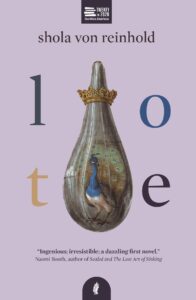
[Jacaranda Books; 2020]
What does it mean to daydream about a past that would not be hospitable to you? Shola von Reinhold’s debut novel, LOTE, dramatizes this question by bringing complex literary-ethical crises and frothy champagne into the archive. The novel follows Mathilda, a queer Black British woman who has escaped from multiple previous instantiations of her life. She lives for her fascination with her “Transfixions,” forgotten artistic and literary figures of the past who have a magical vividness for her. Dodging homelessness in London, she applies on a whim to a mysterious artist’s fellowship in the picturesque European town of Dun. Mathilda arrives to find the residency an austere apprenticeship to a book of impenetrable and joyless critical theory. But in town, she makes a series of far more compelling discoveries: a forgotten Black Scottish poet from the 1920s, a queer kindred spirit with a taste for crêpe de Chine, and a devastating cover-up.
LOTE is a novel about literary recovery, the process of returning to forgotten memory and out of print writers from the past. This endeavor proliferated among feminist scholars in the 1970s and 1980s who sought to correct the male biases of the British literary canon. Since its heyday, recovery scholarship has inspired a parallel bibliography in fiction, made up of novels that narrativize the process of recovery, with all its longing and revelation. Though Vladimir Nabokov’s Pale Fire (1962) came first, the standard of the genre, to my mind, is A.S. Byatt’s Booker Prize-winning Possession (1990). Possession emphasizes the romance of the recovery process, characterizing it as a transhistorical search that builds greedy intimacy between scholars and their objects.
The core tension of a recovery narrative, which LOTE explores in lush detail, is that many lost writers have been forgotten (or, more likely, suppressed) for a reason. Arbiters of taste and preservation deem certain writers frivolous or unimportant, often because of their gender, race, and/or style. Mathilda has to work hard to convince listeners that her main Transfixion, Hermia Druitt, could have really lived as a Black person in Scotland before World War II. Her one known literary work has been lost to time — as far as anyone knows.
The catalyzing event that binds Mathilda to Hermia restages one of the signature moves of the recovery novel: archive theft. When she discovers a labeled picture of Hermia, a Black woman with natural hair and chic clothes, in the National Portrait Gallery archive, Mathilda slips it into her pocket, and the game is afoot. Theft is a recurrent theme in LOTE as in all recovery literature. Mathilda shoplifts to feed herself and clothe herself in luxury apparel. Her friend Agnes, she learns, has been stealing neglected works of Black art from museum archives for 40 years. Possession also begins with a daring act of archival thievery, as does Jordy Rosenberg’s 2018 novel of trans recovery, Confessions of the Fox.
The favored plot point of archival thievery suggests that the driving force of each recovery novel lies in a desire for the past that exceeds what is considered appropriate, professional, and even legal. For Mathilda, her Transfixions offer her a relationship with her predecessors that is more complicated than mainstream culture’s fantasizing about the past. She reflects, “A fondness for old objects and buildings, and an inclination towards historicized figments, were, as far as I was concerned, much easier to inhabit for white people.” For her to daydream about a romanticized history — including and especially the queer-fabulous bohemian era of the Bright Young Things that so many of us love — would be to daydream about a time when she would have even fewer rights than she does in the present.
This limitation ultimately gives her a clarity of vision that white people can’t mount. “Being born in a body that’s apparently historically impermissible, however,” Mathilda reports, “only meant that I was not as prone to those traps that lie in wait for Arcadians — the various and insidious forms of history-worship and past-lust. I would not get thrown off track.”
Von Reinhold takes the responsibility to not get thrown off track seriously. While other recovery novels have explored the marginal status of women, queer, and trans writers, Mathilda fixes her eyes on a form of historical life that the novel’s white academics think utterly impossible: a life of Black queer joy that celebrates luxury, excess, and glamor. Mathilda is joined in her quest by her new friend Erskine-Lily, who she describes as a “living Transfixion,” a gender nonconforming person in spectacular hats who is also obsessed with Hermia and her circle. Together, Mathilda and Erskine-Lily create a style of recovery research that espouses the same virtues of excess; stealing champagne and stealing Hermia’s personal papers from a hidden repository go hand in hand.
In their quest to celebrate the past through pleasure in the present, Mathilda and Erskine-Lily share a research method that is at frequent odds, both comically and frustratingly, with the residency that supports Mathilda. The residency focuses on “Thought-Art,” a self-abnegating creative endeavor inspired by the unreadable philosophical work of Garreaux, an amorphous French theorist that the other residents worship. Each resident must submit “White Book Projects,” white notebooks filled with creative output that are then archived and never read by anyone. The Thought-Artists think themselves radical, talking into the night about “the revolution” and spouting jargon. In one seminar, one participant says inscrutably, “‘If Nepotism is the sweet insolvency, then why not Incest the brave and noble nouveau-bankruptcy?’” to mass approval and nodding. Mathilda, exasperated, thinks, “I desperately wanted to go to bed and read about Hermia.”
At stake in the conflict between Mathilda and the Thought-Artists is the legitimacy of her historical desires. The residents view her flashy clothes and love for the modernist era’s most minor and flamboyant personalities as essentially frivolous. Their own embrace of highbrow theory seems to render them more politically worthy. Mathilda doesn’t see it that way. She describes the Garreauxian philosophy as hostile to embodied expressions of joy and pleasure, in addition to being overwhelmingly, well, male. “The tectonic mascness of it all; that would have you think it neutral,” she complains. For Mathilda and Erskine-Lily, there is real value, and simple sustenance, in embracing the fanciful and femme parts of the past.
Ultimately, they learn that Hermia and her contemporaries had the same philosophy, reviving an ancient secret society called LOTE, or the Order of the Lotus-Eaters, devoted to the consumption of luxuries. Mathilda discovers that LOTE and the Thought-Artists were not only ideological competitors but also historically entangled in devastating ways. The novel forges a causal relationship between the “White” book project of ascetic silence and the silence of a Black bohemian modernist. Through a shocking discovery, Mathilda comes to believe strongly that Hermia has not fallen out of history; instead, she was pushed. Her history has been bricked up, not written, by history’s victors. Those victors are, not coincidentally, the same people who have the funding to create the Dun Residency. Mathilda realizes that to pursue historical truth is often to work directly against institutional and intellectual legitimacy, including that of Garreaux and his disciples.
Although LOTE is a novel, it shares characteristics with works by Kate Zambreno and Jordy Rosenberg that muddy the lines between fiction and criticism. LOTE isn’t a manual for practicing Black literary historiography, but Mathilda’s experiences respond to a series of scholarly traditions with a great degree of intellectual acumen. von Reinhold also uses a variety of formal devices to intertwine Hermia’s story with a variety of real-world figures like Stephen Tennant, Nancy Cunard, and Marchesa Luisa Casati. The novel includes Mathilda’s notes on all these Transfixions, an out of print scholarly book called Black Modernisms, and narrative accounts of Hermia herself. The result is a scrapbook of queer Black attachments, across time.
In addition to fulfilling its academic aspirations, LOTE quite often satisfies as a novel. Mathilda and Erskine-Lily’s journey of discovery features many entertaining twists, and the narrative voice is wry and often extremely funny. When Mathilda visits her dour Residency friends and picks up a book of Henry James from the floor, her friend explains, “Henry James reads like lacerated dick.” von Reinhold derives consistent comedic impact from Mathilda’s bland responses to the fervent Residency crowd, her irreverence growing bolder and more infuriating to them by the day.
The happy ending of any recovery narrative is a reprinting of the lost work and everything it entails. Mathilda uses her contacts in London to help secure a small print run of Hermia’s hidden poem. In recovery literature — and recovery scholarship — print circulation seems to secure the preservation of a beloved object, a text of lasting artistic value. But Mathilda’s love for Hermia isn’t evangelical, or evaluative. She doesn’t detail the contents of Hermia’s long-lost poem, or reveal whether it is as affecting as the mere fact of her presence has been. For Mathilda, the knowledge of a work’s existence, and how it suggests the historical vitality of a marginalized figure, is the most important thing. The Transfixion is the writer herself.
The real victory of LOTE lies in the way that accessing a lost Transfixion helps to anchor Mathilda and her friends’ experiences in the present. Namely, their quest leads Erskine-Lily to identify the trans in Transfixion. They decide that the pronoun he doesn’t work for them, and while they/them doesn’t seem quite right either, it’ll do. We sometimes conceive of nonbinary gender as a new phenomenon. One of the particular affordances of the recovery novel is its power to reorient the progressive structure we assume for many marginalized identities.
As protagonists like Mathilda and Confessions of the Fox’s Dr. Voth uncover the past, they discover precedents for their own experiences that may even transcend what they are able to accomplish in the twenty-first century. Queer theorist Heather Love calls this phenomenon “feeling backward,” although recovery novels tend to be more optimistic about the practice than queer theory is. Since the genre seeks to uncover personages and occasions in the past that we can’t already know, it can also reverse expectations of what was possible in the past. Confessions of the Fox follows a character of color in eighteenth century London, a scene not often figured as racially diverse, as well as a trans man known for his masculine swagger and daring. For Mathilda and Erskine-Lily, whose lives are marginalized by race, gender, and economic precarity in the present, there is real solace across time through their knowledge of Hermia and her nonconforming friends, such as real-life Bright Young Person Stephen Tennant.
The queer history these characters absorb gives them a model for gender transition. But it also interprets transition more widely. Erskine-Lily, with their disregard for contemporary definitions of success and respectability, strikes Mathilda as a living Transfixion. At the end of the novel, she becomes one herself, introducing herself to a new friend as Hermia. For von Reinhold’s characters, the past is indeed “an escape,” akin to those Mathilda has engineered many times to evade her unhappy childhood. But using the past to escape doesn’t mean staying there. Instead, it gives Mathilda the trappings, sartorial and political, to make something new.
Ana Quiring is a PhD candidate in English at Washington University in St. Louis. She writes about twentieth century literatures and feminisms and tweets @AnaQuiring.
This post may contain affiliate links.







